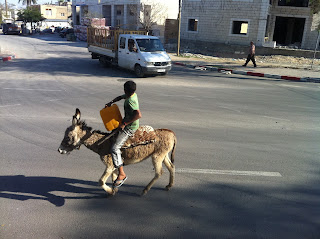Though it was a big part of my interest in coming here, I have been reluctant to write about the political situation. Being here and hearing different perspectives have made me see that it much more complicated than I understood before and I am still trying to put all the pieces together. As my time here is drawing to a close, I will try to start sharing some of what I have learned and my reflections on all this, though the gaps are still many.
Settlements
The picture I had in my mind of Israeli settlements is of religious extremists going out and seizing Palestinian farm land and setting up their own rural villages. Though this style of settlements exists, the reality is very different and much more institutionalized. Settlements are more often urban and suburban than rural and most settlements are within commuting distance to major cities in Israel. Settlers are also motivated by economics as well as ideology; the opportunity for a house with a yard for less than an apartment in Jerusalem. An Israeli professor we spoke with said that most settlers would move if they were given an economic incentive to do so.
Here is a picture of an Israeli settlement- an apartment complex in East Jerusalem.
The reason why freezing settlement is an important condition of peace talks for Palestinians, is that every settlement makes attaining a viable Palestinian state more difficult. Though not all settlers are ideological motivated, from a macro-perspective there is certainly a political strategy to settlements. One of the Palestinian positions in peace negotiations is that East Jerusalem be the capital of their state, but with settlements of tens of thousands of people in and around East Jerusalem this becomes more difficult.
The need to provide settlements with security also adds to the Israeli military presence in the West Bank. Although the Palestinian Authority governs cities in the West Bank, Israel controls the roads and borders. Fences are built along settlement roads, even if their separate people’s houses from their farmland. Until just a few weeks ago, Palestinians could not drive their own cars from Nablus to Ramallah- two West Bank cities, they would have to take a bus to one side of a checkpoint, walk though and then take another bus. Driving through the West Bank- we saw settlers on the road side with large rifles strapped over their shoulders.
Citizenship
I have been trying to get straight which Palestinians have Israeli citizenship and which do not (about 20% of Israel’s population are “Israeli Arabs.” I asked a few member of St. George’s congregation about this after the Arabic service. They told me that those Palestinians living within the territory of Israel after the 1948 are citizens (at that point the West Bank was a part of Jordan). One women was from the West Bank but had married an “Israeli Arab” and so had been able to get citizenship in that way, though she made sure to tell me that this was no longer possible. Residents of East Jerusalem- which has been annexed by Israel as opposed to occupied- have special Jerusalem ID cards but not Israeli passports. They can travel and work freely in Israel, but as far as I can tell are not voting citizens. Palestinians living in the West Bank are not Israeli citizens, and cannot live or travel in Israel without permission. Those residents of the West Bank born prior to 1967 often have Jordanian passport, but I don’t know if these are still available to those people born after that time. It seems like Jerusalemites have many different forms of documentation, but still struggle to get through the checkpoints to go and visit family and friends in the West Bank. Even the Anglican Bishop of Jerusalem, who is from the West Bank, is struggling with the Israeli government over his residency permit.












